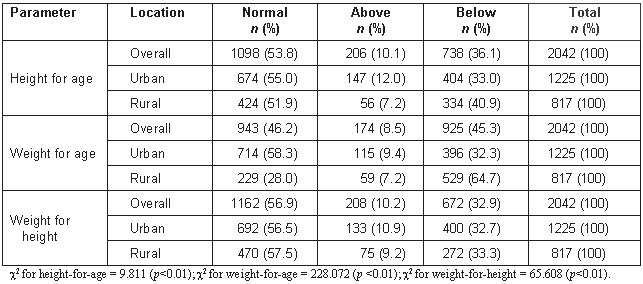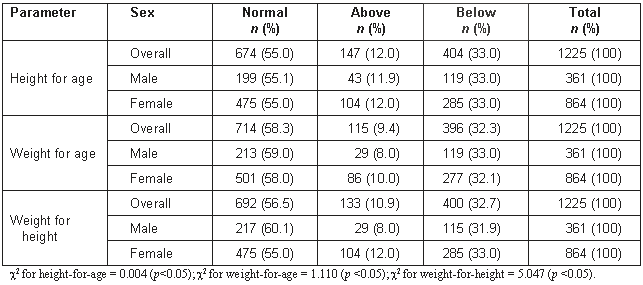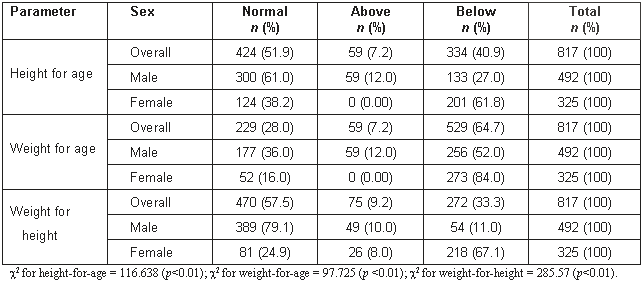Health and nutrition problems are the result of unsatisfactory food intake or severe and repeated infections, or a combination of both. These conditions are closely linked to inadequate access to food, neglected care for mothers and children, insufficient health services and an unhealthy environment1. These parameters are reflected in the standard of living of a population, and whether its basic needs are met, for example with adequate food and healthcare. Disturbances in health and nutrition, regardless of etiology, invariably affect the health of mothers and child growth. Low birthweight babies are prone to frequent infections, leading to undernourished children with a reduced mental capacity. The child who has inadequate food, health and healthcare grows into a stunted adolescent who has a reduced mental capacity2.
The nutritional status of a population can be determined in various ways. Useful parameters include calorie consumption over a given period; intake of protein and other nutrients; neonatal and postnatal mortality; infant mortality; birthweights; and child growth rates3. Growth assessment is the best single measure to define the health and nutritional status of children. There is a definite relationship between children's age, weight and height4; any deviation from the established relationship reflects negligence in the upbringing of the child. The worst crime among many human faults and errors is abandoning a child, thereby neglecting the foundation of a life. Many needs can wait but a child cannot, because his bones are being formed, his blood is being made and his senses are being developed. A child needs to be attended to and tended.
Approximately 38 million children are born in south Asia and one in eight fails to survive to the age of 5 years. Approximately 3 million of these child deaths are directly or indirectly associated with malnutrition5. These babies are born with impaired growth due to poor nutrition during foetal life. Low birthweight is a retrospective marker of the mother's nutritional and health status while it is also a prospective marker of the child's growth and development. In Pakistan, approximately 25-34% infants are of low birthweight, while 40-49% children under the age of 5 years are underweight5. By any standard this is a major human-development problem with profound short- and long-term consequences for individuals, households, communities and the nation. The children suffer from energy malnutrition and often grow up malnourished, stunted or wasted.
In Pakistan, there is a significant difference between urban and rural populations in terms of economic status, lifestyle and nutrition. There is a similar difference between male and female children. Such differences affect the health and nutritional status of affected children. Data on the growth of school-age children that are generated in a consistent manner across countries and over time are difficult to find2. The present study was, therefore, undertaken in order to assess the nutritional and growth status of male and female school-going children aged 6-12 years in rural and urban areas in Faisalabad District, Pakistan.
Methods
Sample collection
Of Pakistan's 140.5 million population, 67.5% live in rural areas and 32.5% are urban dwellers6. The population is highly diverse in terms of socioeconomic status and living conditions. There is widespread disparity in socioeconomic status throughout the country.
The present study focused on a population that represented socioeconomic poor and middleclass. The study was restricted to the industrial city of Faisalabad, the third largest city in Pakistan, and adjoining rural areas. Data were collected from primary schools during the academic year 2000-2001. Schools within the municipal limits (possessing urban amenities) were regarded as urban and those outside municipal limits as rural.
The selection of schools was made arbitrarily, and data were collected from schools that responded positively to the invitation to participate in the study. Hence, the proportion of male : female, and rural : urban children was not representative of either the District of Faisalabad or the country.
Parameters studied
The recorded parameters were age, height and weight. Age was recorded from the school records; weight was determined using bathroom scales; and height was measured using a measuring tape fixed to a wall. The data were used to calculate:
- Height for age: Low height for age (stunting) demonstrates performance in terms of linear growth and is an indicator of having failed to grow. It results from suboptimal health and/or nutritional conditions and is associated with inappropriate feeding habits or repeated exposure to infection.
- Weight for height: Low weight for height (wasting/thinness) reflects reduced body mass relative to chronological age. In most cases it indicates weight loss associated with starvation and/or severe disease.
- Weight for age: Low weight for age (underweight) represents a convenient synthesis of both linear growth and body proportion.
Regional (urban and rural) prevalence of each index was estimated. The number of underweight, stunted and wasted children were obtained by applying available standards7. The data were arranged according to Jelliffe's classification for determination of malnutrition. In this classification, the children whose weight was 90% of the standard weight for their age were considered normal. Those whose weight or height was greater than 10% were regarded as above standard and those below 10% were regarded as stunted, wasted and underweight, respectively. To test the significance of association between independent and dependent variables, Chi-squared (c2) test was used. The calculation was made using the formula:

Data were analyzed using Statistical Package for Social Scientists (SPSS Inc, Chicago, IL, USA; 1999).
Results
A total of 2042 subjects were studied in and around Faisalabad city. There were 853 males (41.8%) and 1189 females (58.2%). The number of urban subjects was 1225 (60%) and rural 817 (40%). The distribution of male and female children between urban and rural locations is shown (Table 1).
Table 1: Distribution of male and female children between urban and rural locations in Faisalabad District, Pakistan

The overall nutritional status of the children studied is reflected in Table 2. The percentage of children whose characteristics fell within the prescribed norms varied between 46.2% and 58.3%, except for underweight among rural children (28%). Those above normal parameters varied from 7.2% (stunting and wasting) to 12% (height for age); however, the percentage of stunted children was high (36.1% overall, 33% urban, 40.9% rural). Wasting among children was high (32.9% overall, 32.7% urban, 33.3% rural); the percentage of underweight children was high (45.3% overall, 32.3% urban, 64.7% rural). The differences between categories were highly significant.
Table 2: Comparison of urban and rural school-going children in Faisalabad District, Pakistan

The nutritional status of urban school-going children is shown (Table 3). Overall, more than 55% of urban school children were normal for age, weight and height. Except for stunting in females (33%), the normal subjects varied from 55% to 60%. This clearly reflects better nutrition among the urban children. Only a small proportion of the children was above standard height for age (12%), weight-for-age (8% male, 10% female) and weight for height (8% male, 12% female). Approximately 33% were below standard for the three parameters. The differences among urban children are significant.
Table 3: Comparison of urban male and female school-going children in Faisalabad city, Pakistan

The situation of the rural school children is different. The data presented in Table 4 reveal that the number of normal rural subjects was lower than the number of normal subjects in the urban group, except for stunting (61% normal males) and weight for age (36% normal males). The percentage of children below the baseline was high. A total of 61.8% females were found to be stunted, as were 27% males; 84% females were categorised as wasted as were 52% males. Regarding weight for height, 67.1% females were below the standard, as were 11% males. The differences in the three parameters studied are highly significant.
Table 4: Comparison of male and female rural school-going children in Faisalabad District, Pakistan

Discussion
The nutritional status of any community is dependent on numerous factors, among them food security, food safety, social status, gender discrimination, women's education, housing, healthcare, supply of portable water and sanitation. Pakistan is a developing country where 25-34% babies have a low birthweight, and 50-59% children under 5 years are underweight5. Weight at birth is a strong predictor for size in later life because most intra-uterine growth retarded infants do not 'catch up' to normal size during childhood. In Asian countries, including Pakistan, the incidence of low birthweight predicts the prevalence of underweight during preschool and subsequent years8. Childhood and adolescent stunting adversely affects the health of adults, and this is so for child-bearing women9.
In Pakistan, the causes of growth retardation are deep-rooted in poverty, the lack of women's education and other manifestations of sex discrimination. These conditions not only perpetuate the vicious cycle of poverty, but also lead to an enormous waste of human potential. The schools from which data were collected varied between those where the poor and middleclass seek admission for their children. The difference between rural and urban children was significant. Urban children now spend time at sedentary in-door activities such as watching television or playing computer games. However, rural children perform more physical activity with less food available and, as a consequence, tend to be underweight.
The physical growth of school children aged 6-9 years depends on environmental and genetic factors and their interaction. Among population groups who have experienced constraints on economic and social development, most of the factors that affect the physical growth of school children are related to the influence of environmental factors before puberty, including poor food consumption patterns, illness, lack of sanitation, poor health and poor hygiene practices10. In the present study, female children in rural areas were found to be grossly stunted (61.8%), wasted (84%) and underweight (67.1%). Differences in the treatment of boys and girls is often evident in healthcare and nutritional status. One in six female deaths is caused by gender discrimination and gross neglect. A strong preference for sons leads to the neglect of female children and their mothers. Female feticide is a growing practice on the Indo-Pakistani subcontinent. If the present trend continues, a significant demographic imbalance could result. At the time of the study, the male : female ratio in Pakistan was 10 : 6, and higher in urban areas, due to male-dominated migration from rural areas as men seek employment 6.
Girls are subject to neglect by their families. Studies of life in Pakistani villages show that male children are fed higher quality food than female children11. Even in families where there is adequate food, girls are served a smaller amount. Mothers and girls eat last, so when an inadequate amount of food is available, the female family members may not eat at all. Another reason for undernourishment in illiterate and poor families is to delay girls' physical development so that parents have an increased amount of time to find a groom and accumulate the resources for a dowry. Besides girls having a lower allocation of food than boys, families spend less on girls' healthcare. Parents see boys as their old-age insurance and thus feed them well and protect them from illnesses. Hospital records show that more boys than girls are brought in for treatment, while girls are usually admitted only when an illness has become critical. Adolescent girls have fewer opportunities for recreation, healthy physical exercise or even exposure to fresh air.
Conclusion
The results of the present study reveal that the higher proportion of stunted, underweight and wasted children are female. Such a situation is undesirable because these girls grow up to be undernourished mothers. This predisposes the fetus to adverse consequences during pregnancy, which may result in a low-birthweight baby, and so the cycle of stunted child, stunted adolescent, undernourished mother and low birthweight baby is repeated.
Recommendations
Considering the results of this and other studies, it is suggested that a comprehensive strategy should be implemented in all developing countries, and Pakistan specifically, in order to prevent infant and child undernourishment. The Government of Pakistan has recognized that an increase in poverty during the 1990s requires urgent attention12. In addition to poverty alleviation, action must be addressed to the underlying factors of food security, food safety, women's education, safe water supply, sanitation and adequate healthcare.
The first step in such a strategy should be a comprehensive school feeding program to help alleviate undernutrition among the children of poor communities. This may also encourage parents to send their children to school, resulting in an increased literacy rate.
References
1. UNICEF. Strategy for improved nutrition of children and women in developing countries. New York: UNICEF, 1990.
2. Administrative Committee on Coordination/Sub-Committee on Nutrition. ACC/SCN, fourth report on the world nutrition situation. Geneva: ACC/SCN & International Food Policy Research Institute, 2000.
3. Islam R. Poverty and its effect on nutrition: some questions based on the Asian experience. In: Nutrition and poverty - papers from the Administrative Committee on Coordination/Sub-Committee on Nutrition (ACC/SCN) 24th session Symposium,March 1997, Kathmandu, Nepal. ACC/SCN Symposium Report Nutrition Policy Paper 16. Geneva: World Health Organization, 1997.
4. National Institute of Health. How children grow. Bethesda, MA: NIH Division of Research Resources, 1972.
5. Gillespie S. 1997. An overview. Nutrition and poverty. In: Nutrition and poverty - Papers from the Administrative Committee on Coordination/Sub-Committee on Nutrition (ACC/SCN) 24th session Symposium, Kathmandu, March 1997. ACC/SCN Symposium Report Nutrition Policy Paper 16. Geneva: World Health Organization, 1997; 1-18.
6. Government of Pakistan. Economic Survey 2000-2001. Islamabad: Government of Pakistan, Economic Adviser's Wing, Finance Division, 2001.
7. Vaughan III VC, Litt IF. Growth and development. In: RE Behrman, RM Kliegman, WE Nelson, VC Vaughan III (Eds). Nelson textbook of pediatrics. Philadelphia: WB Saunders, 1992.
8. Mason JB, Hunt J, Parker D, Jonsson U. Investing in child nutrition in Asia. Asian Development Review 1999; 17: 1-32.
9. Allen L, Gillespie S. What works? A review of the efficacy and effectiveness of nutrition interventions. Administrative Committee on Coordination/Sub-Committee on Nutrition, Nutrition Policy Paper No. 19. Geneva: World Health Organization, 2001.
10. Habicht J-P, Martorell R, Yarbrough C, Malina R, Klein RE. Height and weight standards for preschool children: Are there really ethnic differences in growth potentials? Lancet 1979; 1: 611-615.
11. Department of Women and Child Development, Ministry of Human Resource Development, Government of India. The lesser child. In: Sub-Committee on Nutrition News 1990; 6: 24-25. Extracts from: SCN News May 1990.
12. Government of Pakistan. Three year poverty reduction programme 2001-2004. Draft for public discussion. Islamabad: Pakistan Planning Commission, 2001.

